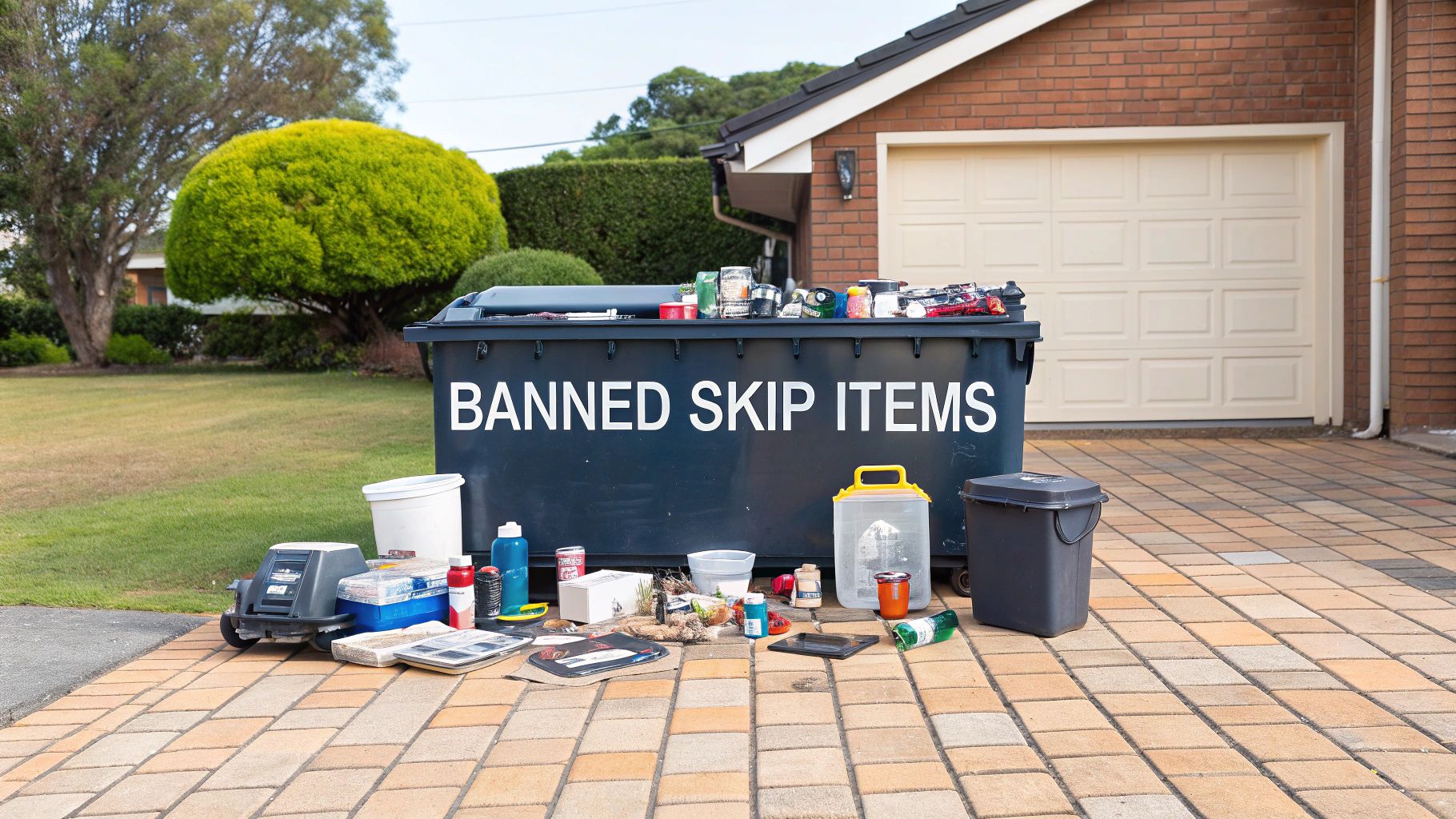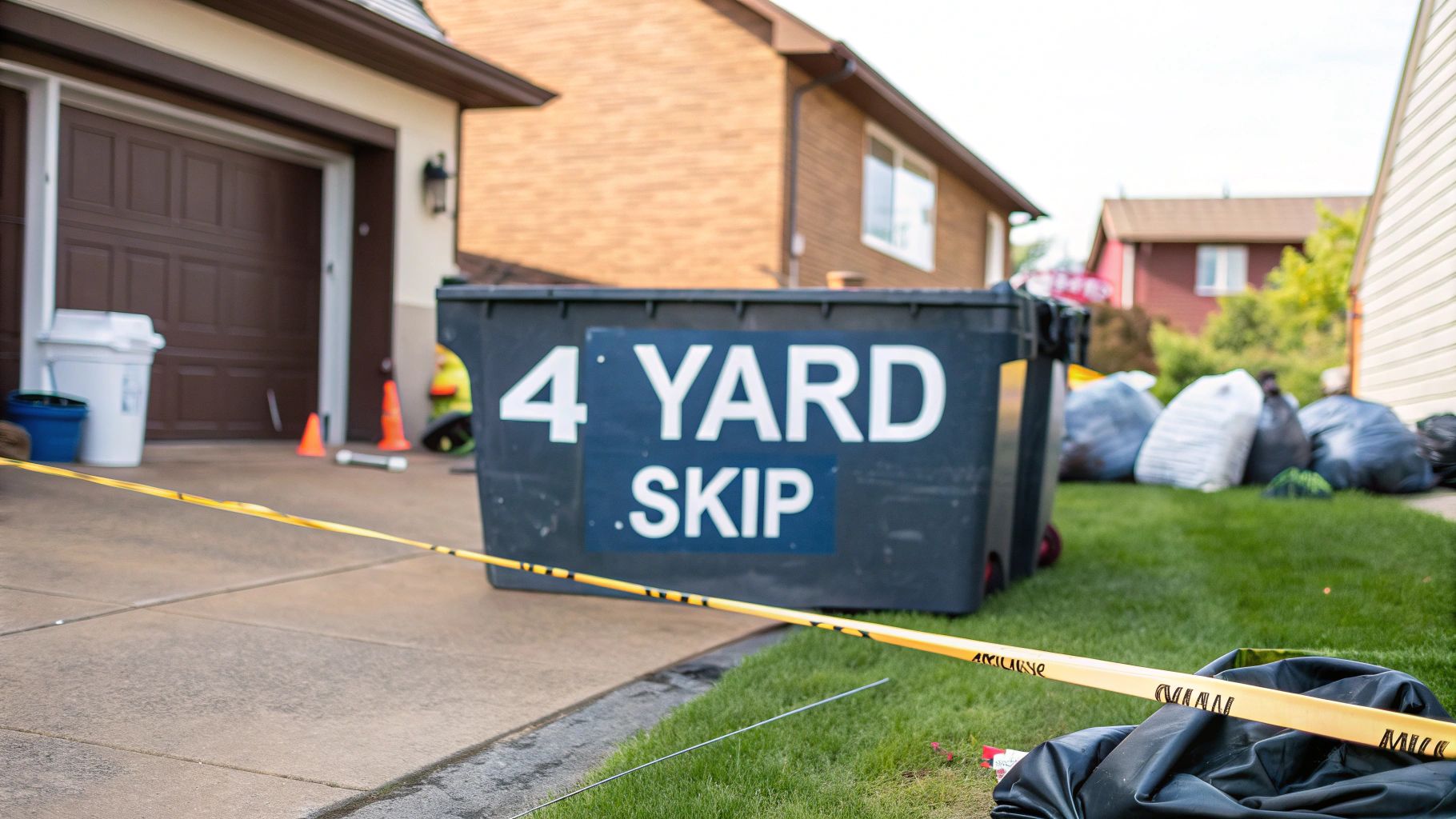Hiring an Asbestos Skip Bin a UK Safety Guide
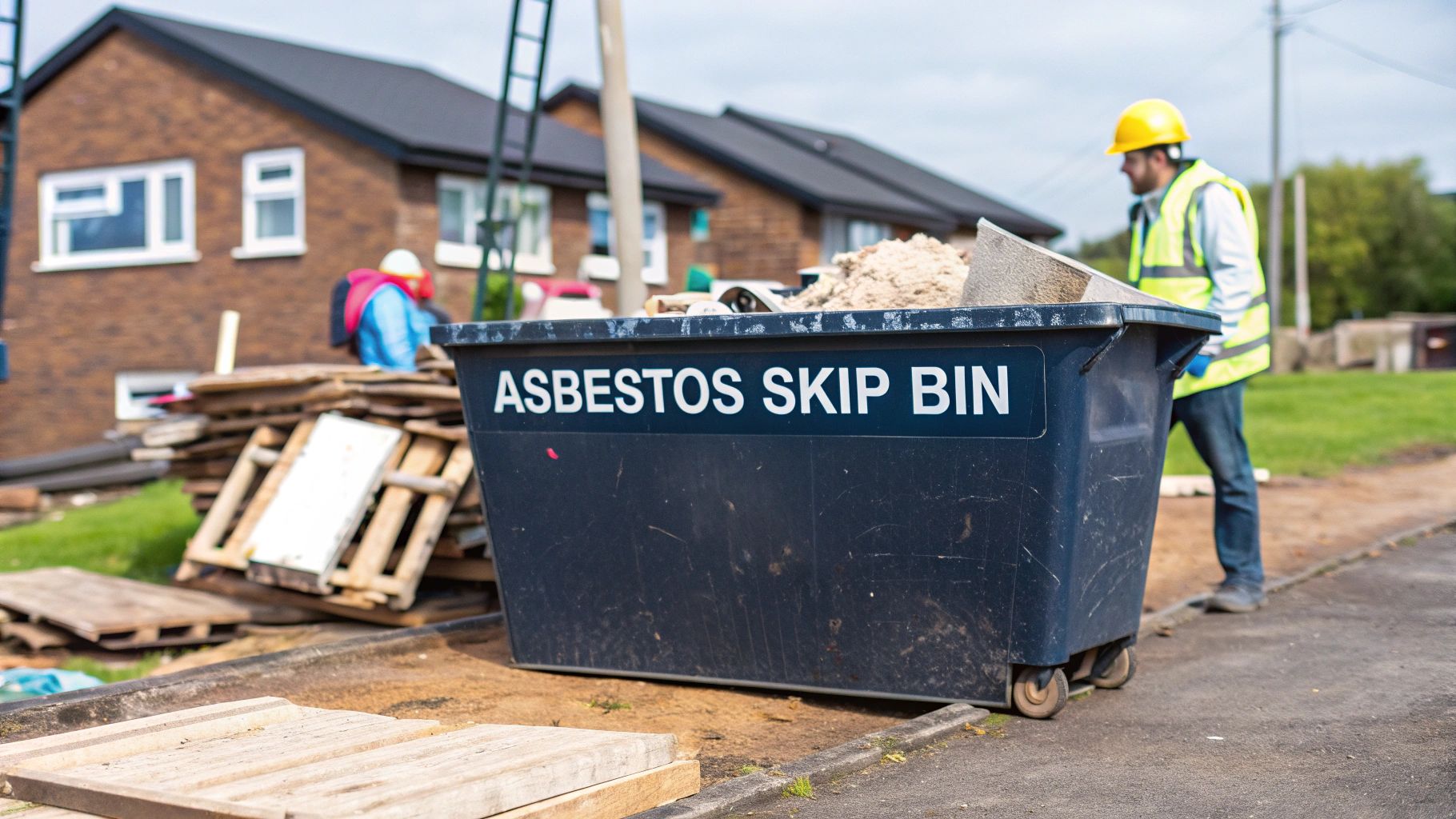
Hiring an Asbestos Skip Bin a UK Safety Guide
So, what exactly is an asbestos skip bin? Simply put, it's a purpose-built, legally compliant container made exclusively for getting rid of asbestos waste safely. You can't just toss asbestos into a standard skip you'd use for old garden cuttings or building rubble. This is a whole different beast, kitted out with crucial safety features like a lockable lid and thick plastic lining to stop any dangerous fibres from getting out.
Understanding the Purpose of an Asbestos Skip Bin
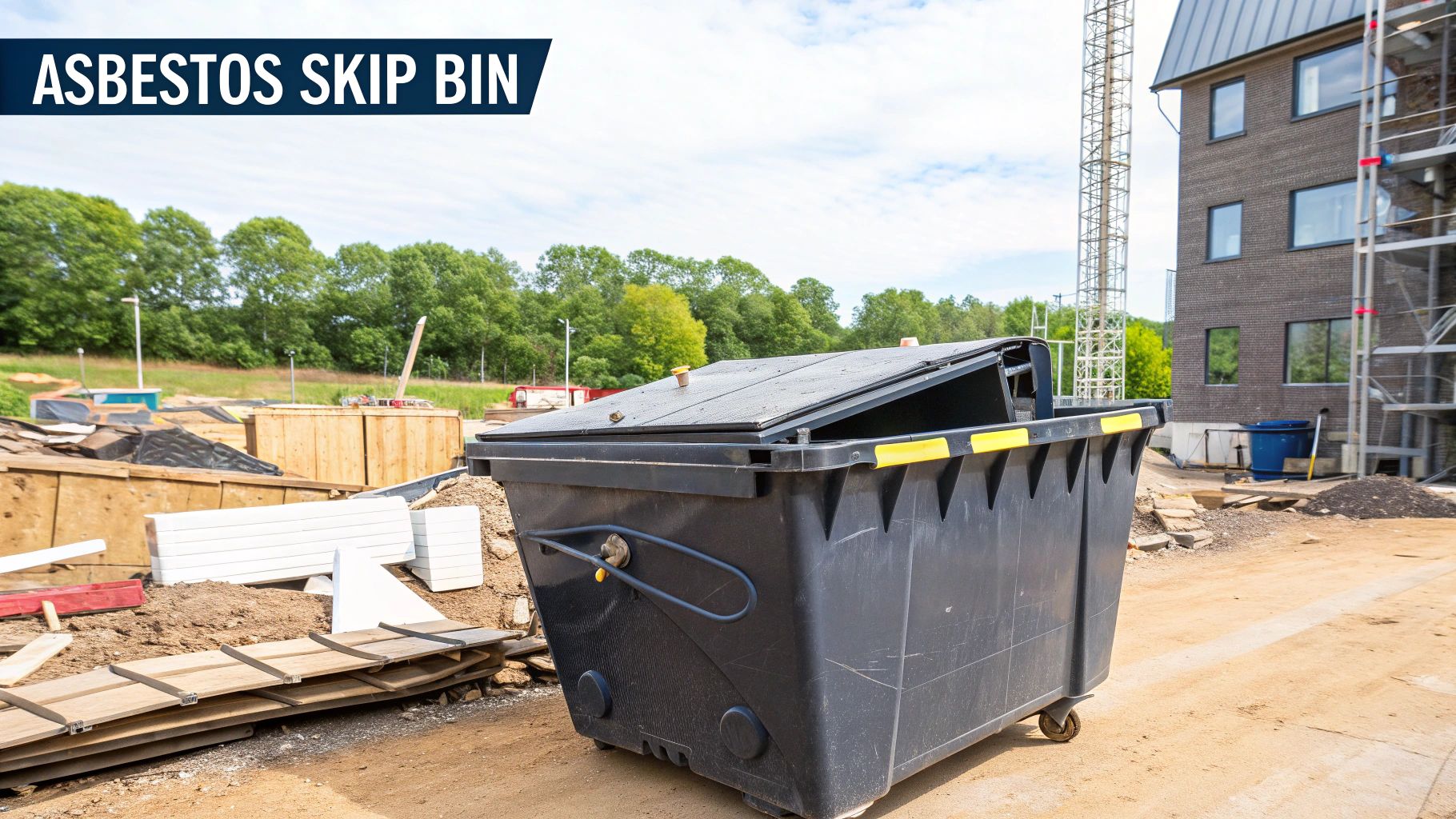
Think about the difference between your regular kitchen bin and one of those secure, bright yellow containers for medical waste you see at a hospital. One’s for everyday rubbish, the other is engineered to contain hazardous stuff and keep everyone safe. That’s the perfect way to think about an asbestos skip bin. It’s not just a box for waste; it’s a critical part of a highly regulated system for managing a seriously dangerous material.
There’s a good reason these specialised bins are a legal must-have. When asbestos fibres get into the air, they're completely invisible and can cause devastating, life-threatening diseases if you breathe them in. Because of this, the absolute number one job of an asbestos skip bin is total containment.
Asbestos Skip Bin vs Standard Skip Comparison
It's easy to see why a standard skip just won't cut it for asbestos. The differences are all about safety and compliance. Here’s a quick breakdown:
| Feature | Asbestos Skip Bin | Standard Skip |
|---|---|---|
| Lid | Fully enclosed and lockable (mandatory) | Often open-topped or with a loose lid |
| Lining | Must be double-lined with 200-micron plastic sheeting | No lining required |
| Construction | Heavy-duty, reinforced steel to prevent punctures | Standard steel construction |
| Labelling | Must display clear asbestos warning labels | No specific warning labels required |
| Transport | Requires a licensed hazardous waste carrier | Can be transported by any standard skip lorry |
| Disposal | Taken only to a licensed hazardous waste facility | Taken to a general waste transfer station |
As you can see, every aspect of an asbestos skip bin is designed to create a sealed, secure environment. It's a system built from the ground up to prevent contamination.
Core Features That Ensure Safety
To do its job properly, every asbestos skip bin has specific features that set it miles apart from the standard skips you see on driveways. These aren't just nice-to-haves; they are legally required for safety.
- Lockable Lids: The bin has to be completely enclosed and lockable. This stops anyone from getting in and makes sure the contents stay put during transport.
- Reinforced Steel Construction: These things are built tough. The robust design prevents accidental rips or punctures that could let fibres escape.
- Thick Plastic Lining: Before a single piece of asbestos goes in, the bin must be lined with heavy-duty plastic sheeting, typically 200 microns thick. This creates an inner seal, making sure the asbestos materials never even touch the bin's metal walls.
Even though the UK banned all types of asbestos back in 1999, we're still living with its legacy. It’s estimated that a staggering 1.5 million buildings in the UK—homes, schools, you name it—still contain asbestos, adding up to around six million tonnes of the stuff. You can find out more about the widespread impact of asbestos in the UK on specialised sites like Asbestos Surveys.
An asbestos skip bin is essentially a fortress for hazardous waste. Its design is laser-focused on one single goal: to keep dangerous asbestos fibres securely locked away from the moment they leave your property until they arrive at a licensed disposal site.
When you hire a proper asbestos skip bin, you’re not just getting a disposal service. You’re taking part in a legally required process that protects your family, your community, and the environment from the very real dangers of asbestos exposure.
Navigating Asbestos Disposal Laws in the UK

Getting rid of asbestos isn't like your average weekend clear-out. It’s a process hemmed in by strict, unbendable laws designed to keep everyone safe. The key piece of legislation here in the UK is the Control of Asbestos Regulations 2012. This isn't just bureaucratic waffle; it's a vital legal framework built to prevent serious public health disasters.
Think of these regulations as the rulebook for a very dangerous game. If you break the rules, you're not just risking a slap on the wrist. Getting it wrong can land you with eye-watering fines of up to £20,000 or even jail time. And for good reason – every single asbestos fibre that gets loose is a direct threat to people's health.
The UK’s legal stance on asbestos is one of the toughest in the world, and it’s been tightened progressively over decades. The journey started way back in 1931 and culminated in a complete ban on all types of asbestos by 1999. But the legacy of its past use means any removal work today absolutely must be handled by licensed professionals, using a compliant asbestos skip bin to ensure nothing escapes into the environment. If you're curious, fibresafe.com has a great piece on the history of asbestos in UK homes.
So, What Are Your Legal Responsibilities?
Figuring out who's responsible for what is absolutely crucial if you want to stay on the right side of the law. There's a "duty of care" placed on anyone who produces, handles, or disposes of waste. When that waste is as hazardous as asbestos, that duty becomes incredibly serious.
- For Homeowners: If the asbestos waste comes from your property, the buck stops with you to make sure it's handled and taken away correctly by a licensed carrier.
- For Contractors: You carry a heavy professional and legal responsibility. You have to manage asbestos waste by the book, protecting your clients, your team, and the general public.
- For Waste Carriers: Any company providing you with an asbestos skip bin must hold an Upper Tier Waste Carrier Licence from the Environment Agency. No licence, no deal.
This chain of responsibility creates a clear, documented, and legally sound trail from the moment the asbestos leaves your site to the second it's safely buried.
The Paper Trail That Protects You
A massive part of this legal process comes down to paperwork. The single most important document you’ll deal with is the Hazardous Waste Consignment Note. This is much more than a simple receipt – it’s your legal proof that you did everything correctly.
Think of the consignment note as a passport for the asbestos. It tracks the waste on its journey from your site to the licensed disposal facility, proving you’ve met your legal duty of care. If you don't have one, you have zero evidence of proper disposal.
When you're hiring an asbestos skip bin, you need to make sure your provider ticks these legal boxes:
- Check Their Licence: Before you even think about booking, ask to see their Upper Tier Waste Carrier Licence. Any reputable, professional company will have it ready to show you.
- Get the Consignment Note Sorted: Your provider will give you a multi-part consignment note and help you fill it out. It details exactly what the waste is, how much there is, where it came from, and where it’s going.
- Confirm the Final Destination: The skip has to go to a landfill that is specifically licensed to take asbestos. The consignment note will name this exact location.
By making sure these legal steps are followed, you're not just ticking boxes. You're playing a vital role in a system designed to protect our communities and the environment from a very real and lasting threat. For a more detailed look at the rules, take a look at our guide on hazardous waste disposal regulations.
Your Step-by-Step Guide to Hiring an Asbestos Skip Bin
Hiring a skip for asbestos isn't as simple as ordering one for a weekend garden clear-out. It’s a tightly regulated process, and for good reason—public safety is on the line. Getting it right means following a clear set of steps, from finding the right company to waving goodbye to the sealed container.
Think of it as a chain of custody. Your responsibility starts with thorough research and only ends when you have the paperwork proving the asbestos has been disposed of safely and legally.
Finding and Vetting Your Provider
Your first job, and the most important one, is to track down a reputable and fully licensed waste carrier. Don’t just take their word for it; you need to see proof. A legitimate company will have no problem showing you their Upper Tier Waste Carrier Licence, which is issued by the Environment Agency. This isn't just a nice-to-have, it’s the non-negotiable document proving they are legally allowed to transport asbestos.
Before you even think about booking, you need to ask a few direct questions. This isn't being difficult; it's you doing your due diligence to steer clear of cowboy operators and the serious legal trouble they can land you in.
Here’s what you need to ask any potential provider:
- Can you please send me a copy of your Upper Tier Waste Carrier Licence?
- Will I receive a Hazardous Waste Consignment Note as legally required?
- Which specific licensed disposal site will you be taking the waste to?
- Are your skips purpose-built for asbestos, with lockable lids and liners?
A professional, trustworthy company will have the answers and paperwork ready. If you sense any hesitation or they get cagey, walk away. It’s a massive red flag.
This simple infographic breaks down the three main stages of the process.
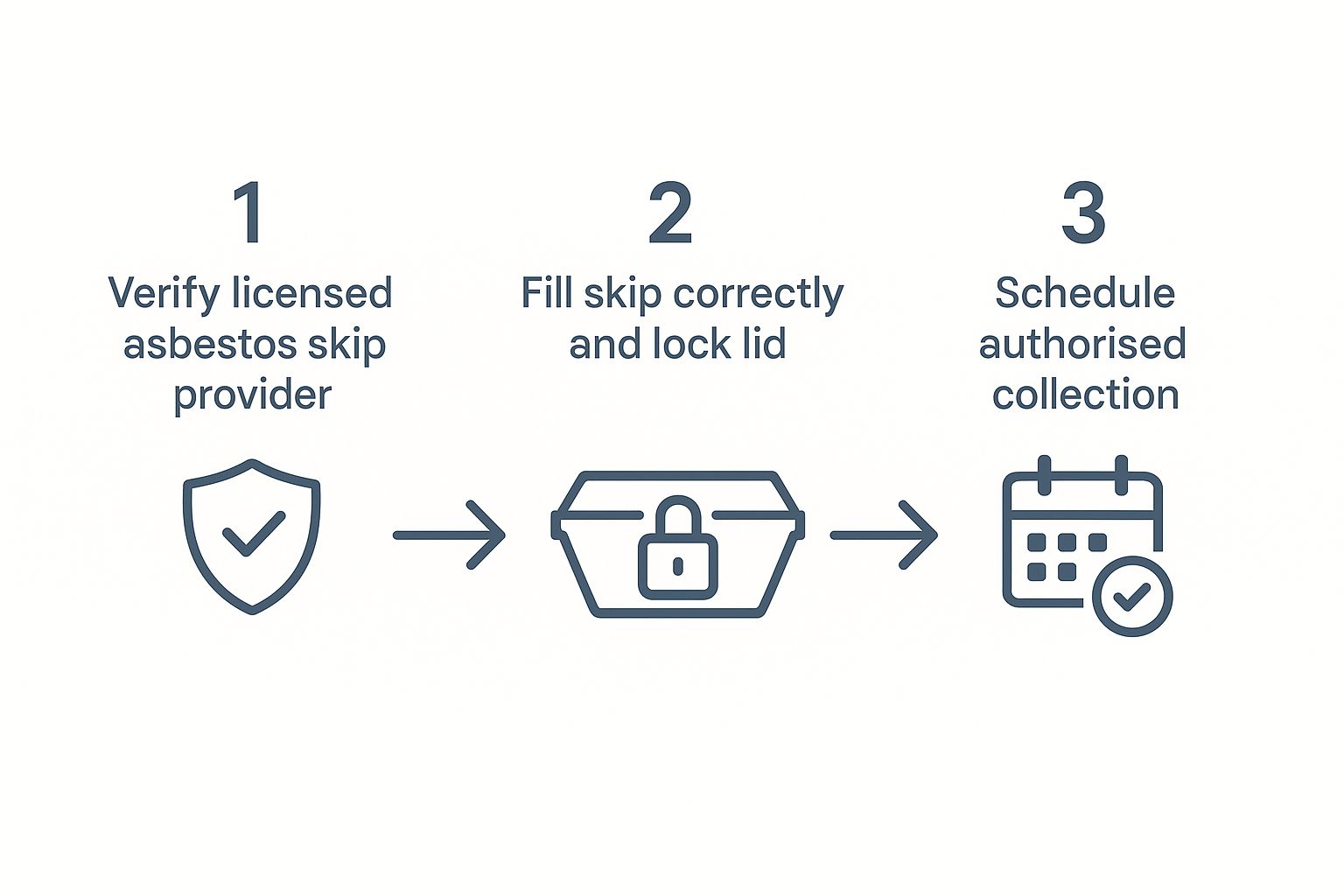
It really boils down to three core pillars: verifying your supplier, filling the skip correctly, and arranging an authorised collection.
Booking, Filling, and Collection Logistics
Once you’ve picked your provider, it’s time to sort out the practical details. You'll need to agree on a delivery date and make sure you have a safe, easily accessible spot for the skip. Picking the right size is also key to avoiding problems later. If you're unsure, you can learn more about what size skip you might need in our handy guide.
When your asbestos skip arrives, you’ll see it’s been double-lined with heavy-duty plastic sheeting. You must take great care when filling it to prevent any of those dangerous fibres from becoming airborne.
Crucial Rule: All the asbestos waste must fit comfortably inside the skip. The lid has to close and lock without you having to force it shut. Overfilling an asbestos skip is not only illegal but incredibly dangerous.
As soon as you’ve finished loading, lock the lid securely. The final step is to call your provider and schedule the collection. Their specially trained team will collect the sealed container and transport it directly to the designated licensed landfill. You’ll then receive your completed consignment note, which is your legal proof that you’ve done everything by the book.
Essential Safety Procedures for Handling Asbestos
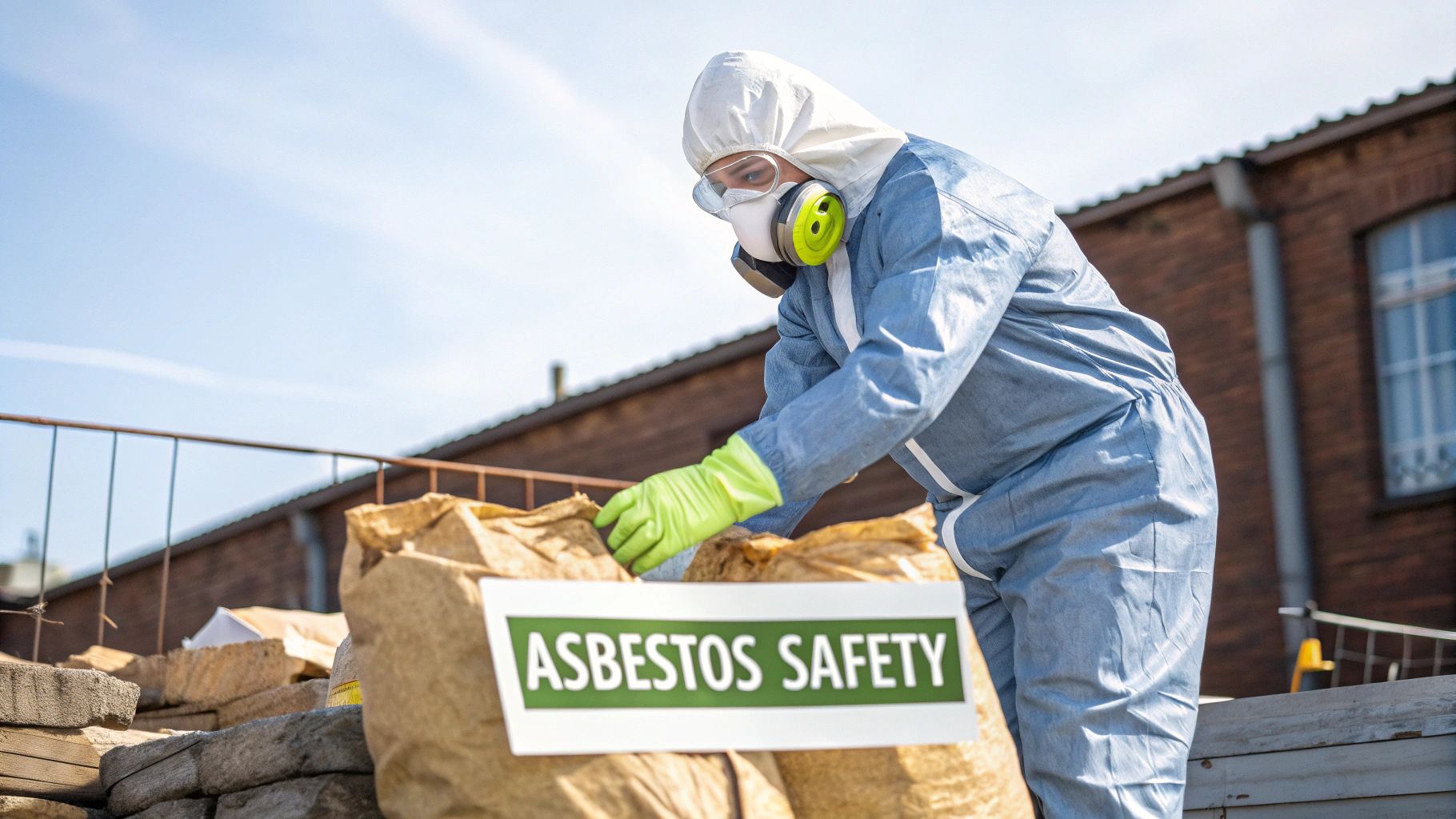
When you're dealing with asbestos, safety isn't just a box-ticking exercise; it’s a life-saver. The real danger comes from the microscopic fibres that break free from asbestos-containing materials (ACMs). They're completely invisible, have no smell, and are incredibly dangerous if inhaled.
Because of this, you absolutely must follow a strict safety protocol before, during, and after filling an asbestos skip bin. It's simply not negotiable.
The whole process starts long before you even think about touching the asbestos itself. Your number one goal is to stop those fibres from getting into the air in the first place. The best way to do that is to gently wet the materials down using a low-pressure water sprayer. This dampens the surface and suppresses the dust, keeping those dangerous fibres contained.
Your Personal Protective Equipment Checklist
Personal Protective Equipment (PPE) is your last line of defence. Let's be clear: a standard decorator's overall or a simple dust mask offers zero real protection. They give you a false sense of security while doing absolutely nothing to stop you from breathing in asbestos. You need specialist gear.
Here’s what your essential PPE kit must include:
- FFP3 Respirator Mask: This is the legal minimum for a reason. An FFP3 mask offers a high level of filtration that’s designed to capture tiny asbestos particles. Crucially, it must be properly face-fitted to create an airtight seal.
- Disposable Coveralls: Look for Type 5/6 coveralls. These are made to stop particles from getting through. Make sure they have a hood and elasticated cuffs to form a complete barrier.
- Safety Goggles: An obvious one, but essential for protecting your eyes from any dust or debris.
- Disposable Gloves: Always use sturdy, disposable gloves. For extra security, seal them over the cuffs of your coveralls with strong tape.
It’s vital to remember that all this PPE is single-use. As soon as you’re finished, everything from the coveralls to the mask must be carefully treated as asbestos waste itself. It all needs to be bagged up for disposal along with the rest of the materials.
The Correct Bagging and Sealing Method
Just chucking asbestos into a skip is illegal, irresponsible, and incredibly dangerous. Every single piece of waste has to be meticulously double-bagged to ensure it's fully contained. This creates a vital double-layer of protection against any accidental rips or tears.
Follow these steps to the letter for every item:
- Use UN-Approved Bags: You must use the proper heavy-duty, red asbestos waste bags that are clearly marked with the correct warnings.
- First Bag: Carefully place the dampened asbestos material inside the first red bag. Gently push out any excess air before folding the top down.
- Seal It: Use strong tape to securely seal the top. The "swan neck" folding technique is the best way to make it completely airtight.
- Second Bag: Now, place that sealed bag inside a second, completely clean asbestos bag.
- Final Seal: Repeat the exact same sealing process, making sure the outer bag remains clean and free from any dust.
Once double-bagged, the waste is ready to be carefully placed inside your lined asbestos skip. Never, ever drop or throw the bags in, as the impact could easily damage them.
If you’re worried you might have made a mistake along the way, our guide on what to do if you've accidentally disturbed asbestos is a must-read. And when bringing in professionals for such a sensitive job, ensuring contractor safety and compliance is another critical piece of the puzzle.
Understanding Asbestos Skip Bin Hire Costs
When you first get a quote for an asbestos skip bin, the price can be a bit of a shock, especially when you compare it to a standard skip for general rubbish. This isn't companies trying to pull a fast one; the higher cost is a direct result of the incredibly strict, legally-required process for handling such a dangerous material.
What you’re really paying for is peace of mind – safety, full legal compliance, and making sure the environment is protected.
Think of it this way: it’s the difference between posting a birthday card and sending a fragile, priceless antique with a specialist courier. The courier service includes special handling, insurance, detailed tracking, and a guarantee of secure delivery, all of which costs more. Hiring an asbestos skip is exactly the same principle. You're covering a whole chain of specialised services that a normal skip hire just doesn't touch.
What Determines The Final Price?
Several key factors all feed into the total cost of hiring an asbestos skip bin. Getting your head around these elements helps you see where the money goes and allows you to budget more accurately for your project.
The final price is essentially a package deal covering a number of non-negotiable, essential components:
- Skip Size and Hire Duration: It’s simple – bigger skips cost more. How long you need it for can also nudge the price up or down.
- Specialised Transport: The collection isn't done by any old lorry. It requires drivers who are properly trained to handle hazardous waste and vehicles that are licensed for the job.
- Hazardous Landfill Fees: Landfill sites that are licensed to accept asbestos charge a lot more for disposal. These fees, often calculated by weight, cover the significant cost of burying the material safely to ensure it never poses a risk again.
- Mandatory Consignment Note: There's a fee for processing the Hazardous Waste Consignment Note. This is the crucial legal document that proves you've disposed of the waste correctly and responsibly.
- Safety Materials: The price often bundles in essential safety gear, like the thick plastic lining for the skip and the UN-approved asbestos waste bags.
The price difference is a direct reflection of the legal "duty of care." You're not just renting a container; you are paying for a fully documented, compliant, and safe hazardous waste disposal service from start to finish.
Breaking Down The Cost Components
To give you a clearer picture of how these pieces fit together, let's look at a typical quote. While the exact numbers will vary depending on your location and the company you choose, the cost structure is pretty consistent across the board. This transparency helps you spot any hidden fees and understand the true value of a compliant service.
Here’s a table showing what you can expect to see on an itemised quote.
Example Cost Breakdown For Asbestos Skip Hire
| Cost Component | Description | Example Price Range (£) |
|---|---|---|
| Skip Hire Fee | The base cost for renting the physical skip container for a set period. | £120 – £250 |
| Hazardous Waste Transport | The charge for collection and delivery by a licensed carrier with trained staff. | £80 – £150 |
| Landfill Disposal Fees | The cost per tonne charged by the specialised landfill. This is the biggest variable. | £150 – £300 per tonne |
| Consignment Note Fee | An administrative charge for processing the legally required paperwork. | £25 – £50 |
| Safety Consumables | The cost of the mandatory plastic lining and approved asbestos waste bags. | £20 – £40 |
| VAT | Value Added Tax at the standard rate of 20% applied to the total. | Varies |
As you can see, the final bill is built from several crucial services, not just the bin itself.
While this is all specific to hazardous waste, the principles of budgeting for specialised services often overlap with other areas. For instance, you can see similar breakdowns when understanding furniture storage costs in the UK. Ultimately, investing in a proper asbestos skip hire is an investment in public health and your own legal protection, making sure a truly dangerous material is dealt with the right way.
Common Mistakes to Avoid with Asbestos Disposal
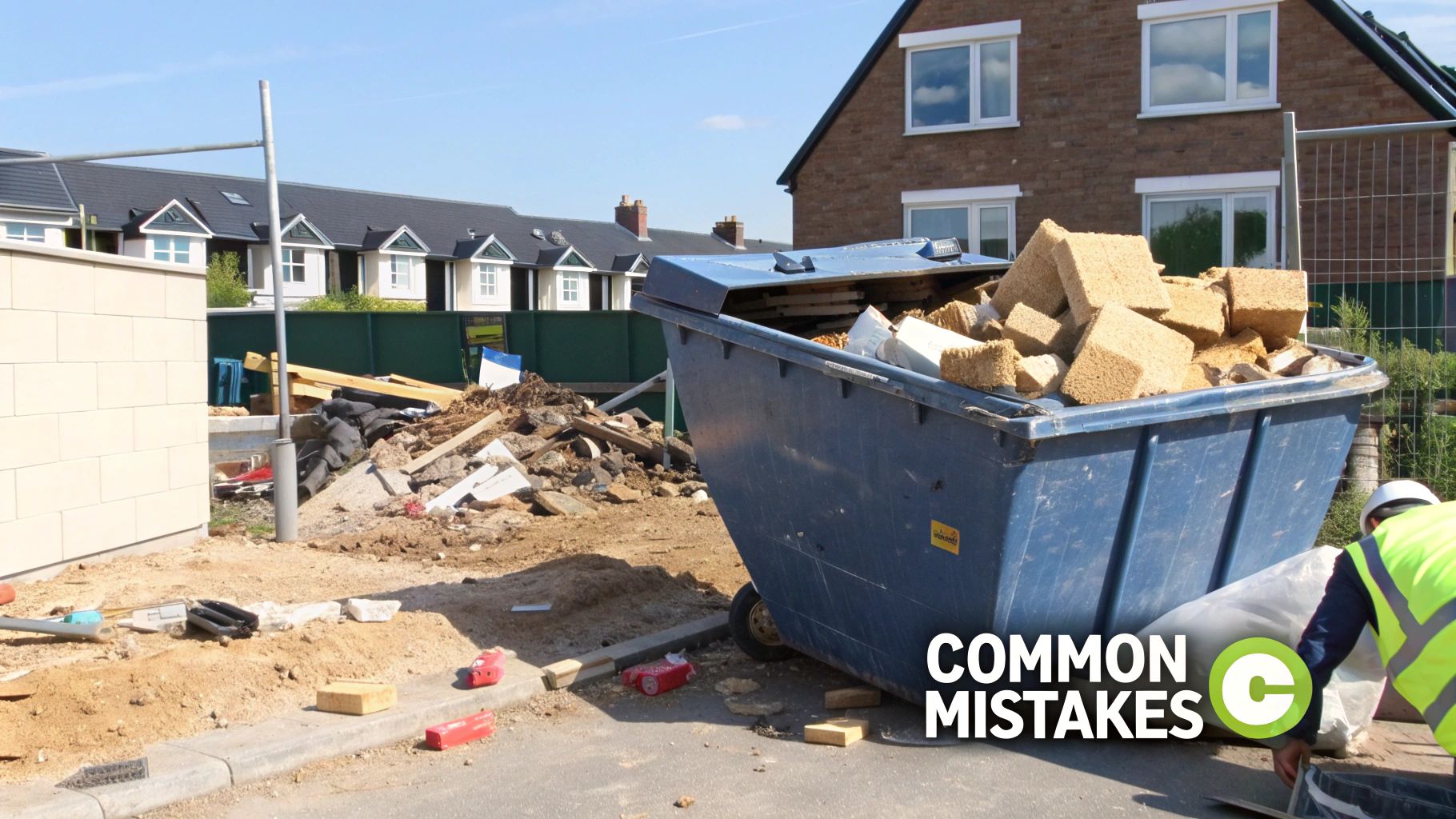
Dealing with asbestos is a zero-tolerance game. It's a high-stakes job where even what seems like a minor slip-up can lead to some seriously grim consequences. Getting a handle on the common pitfalls is absolutely vital for making sure your project gets done safely, legally, and without putting people's health on the line or landing you with a massive fine.
The single biggest mistake we see? People treating asbestos like it's just another bit of rubbish. It absolutely is not. Asbestos is legally classified as hazardous waste, which means it can never be tossed in with your general household or construction waste. Putting it in a standard skip or your weekly council bin isn't just irresponsible, it's against the law.
This separation is non-negotiable. When you mix waste, you create a contamination nightmare, putting everyone from the bin collectors to the staff at the sorting facility at risk of exposure. The only place for correctly bagged asbestos is inside a dedicated, specially lined, and sealed asbestos skip bin. No exceptions.
Overfilling the Skip and Breaking Materials
A classic blunder is trying to cram too much into the skip. The lid on an asbestos skip isn't just for show; it has to close and lock completely without you having to wrestle with it. If it’s overfilled, it can’t be sealed properly. That means it can’t be transported safely or legally, and dangerous fibres could easily escape.
Just as bad is the temptation to snap bigger asbestos sheets to make them fit. This is, without a doubt, one of the worst things you could possibly do. Asbestos-containing materials like cement sheets are relatively safe when they’re left in one piece. The second you break, drill, or smash them, you release a cloud of millions of invisible, deadly fibres into the air around you.
The golden rule of handling asbestos is simple: disturb it as little as possible. Deliberately breaking it up creates an immediate and severe risk for you and anyone in the vicinity. Always handle it gently and keep the materials whole.
Ignoring the Paperwork and Using Unlicensed Carriers
Don't make the mistake of treating the paperwork as just another formality. That Hazardous Waste Consignment Note is your legal proof that you've disposed of the material correctly. If you don't get one or you lose your copy, you'll have no leg to stand on if the authorities start asking where your asbestos waste went.
And finally, trying to save a few quid by hiring an unlicensed carrier is a disaster waiting to happen. Only companies holding an Upper Tier Waste Carrier Licence have the legal right to transport asbestos. If you use an unlicensed operator, you’re not only risking prosecution for failing your 'duty of care', but there’s a very high chance your waste will just be fly-tipped, creating a toxic mess for someone else to find. Always, always check your provider’s credentials before you hire them.
Got Questions? We've Got Answers
What Kind of Asbestos Can Actually Go in the Skip?
This is a crucial point. Generally, these skips are designed for bonded (non-friable) asbestos only. Think things like old asbestos cement sheets, guttering, or roof tiles.
The really dangerous stuff, friable asbestos (the crumbly kind you might find in pipe lagging or insulation), is a completely different ball game. That requires a specialist Class A licensed contractor for removal and can't go in a standard asbestos skip. It’s always best to double-check with your skip provider to be absolutely sure what they can legally handle.
Is There Any Paperwork I Need to Hang On To?
Absolutely. Once your skip is collected, you must get a copy of the Hazardous Waste Consignment Note from the carrier. Don't lose it!
This document is your official, legal proof that you've done everything by the book and the asbestos has been correctly transferred to a licensed disposal facility.
For safe, compliant, and reliable asbestos disposal services, you can trust the experts at The Waste Group. Find out more or book your asbestos skip bin today by visiting https://www.thewastegroup.co.uk.
